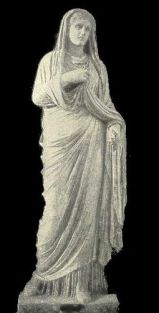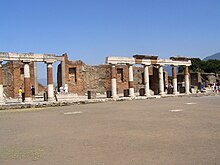Introduction
As one may assume, the study of textiles—let alone women’s position in their production and sales—presents some challenging obstacles mainly, perishable evidence. Textiles and the tools used to make them are often victims to the ravages of time. Moreover, the study of women also provides a challenge as evidence for the average working women is scarce in both a literary and archaeological context. As one author put it “we possess lamentably little information about the weaving and clothing industry of the Roman empire” [1]. It is because of the scarcity of evidence for women and textiles that women in textile production and commerce appear to us as a marginal group [2]. The difficulty in recreating the image of women in textile production and commerce does not mean that we should neglect them. Sources such as funerary evidence and votive offerings, the Corpus Inscriptionum Latinarum, an epigraphic collection of Latin inscriptions both public and personal, iconographic evidence from Pompeii that depict women fullers, and Eumachia, a priestess who funded a textile guild, all present an image of women in textile production and commerce. The importance of women in textile production and commerce comes from the importance of textiles in Ancient Mediterranean societies and economies. Textile production formed a vital part of the Roman economy, they were professionally manufactured and exported throughout the Mediterranean world [3]. Additionally, the study of women in the textile economy is integral for creating the image of women’s position within Roman society; because textiles were one of the areas of the ancient world that women could participate in. However, due to the scarcity of evidence the study of women and textiles have long been overlooked. Nevertheless, the study of women in the production and sales of textiles helps to create a more complete image of women’s socio-economic roles in the Ancient Roman world.
Loom weights in pre-Roman Italy
Loom weights were integral to the to the production of textiles; they were used to keep the fabric taut during their manufacturing [4]. Many loom weights have been recovered from sites all over Rome and constitute a large body of the material evidence for textile

manufacturing. Often when loom weights are recovered in large quantities they are classified as votive offering [5]. However, as Gleba notes, just because the material was recovered in the vicinity of a sacred significance it does not automatically mean these loom weights were votive [6]. Many textile workshops have been archaeologically identified in sanctuaries. For example, in the sanctuary Santa Venera at Paestum large numbers of loom weights have been found. According to Gleba, none of the weights found were in a votive context; rather the large accumulation of loom weights suggests that textile production took place within the sanctuary [7]. Additionally, a sanctuary near Paestum—known as the Square Building—attests to the manufacturing of textiles being done at this sanctuary, possibly for sacred garments, because of the amount of loom weights found it is believed this sanctuary had three looms [8]. The abundance of loom weights found in sanctuaries from the pre-Roman period suggest that textiles and textile manufacturing in the Roman context were important symbolically to women who often played a role in the production of textiles a weavers and spinners [9].
Roman Women and the Commercial Production of Textiles
Evidence for Roman women in textile production can be gathered from iconographic sources, specifically those from Pompeii. The wall painting of the fullers—an occupation involving textile work like dyeing, washing, and drying garments—at work from Fullonica VI 8, 20.21-2 at Pompeii (Fig. 1) shows

that women in Rome were generally only involved in the last phases of the textile process while the men were responsible for the more physically demanding jobs. Moreover, epigraphic inscriptions dedicated to the Statilii family mention the quasillariae [10], a group of spinners that was all women. More importantly epigraphic evidence mentions the lanipendae, or the masculine lanipendi, were the wool-weighers in charge of weighing the daily amount of wool given out [11]. According to Andrew Wilson the lanipendi were also likely to have overseen the whole process of textile manufacturing within the household [12]. The presence of a female in a traditionally masculine and possibly supervisory role suggests the production of textiles was a position in which Roman women could contribute to the city.
Roman Women and the Sales of Textiles
Iconographic and epigraphic evidence demonstrate that Roman women held roles in the commercial production of textiles; however, these were often less physically demanding tasks. Epigraphic and iconographic evidence also supports the idea that these less physically demanding tasks often included the sales of textiles. This is demonstrated on a wall painting at the entrance of the shop of Verecundus in Pompeii. The wall painting depicts a woman selling textiles to a customer and managing the shop on the left side of the entrance (Fig. 2)

and men working with textiles on the right side (Fig. 3) [13].

This supports the idea that “[…] women tend[ed] to be involved in the sales or less physical work”[14]. Similarly, epigraphic evidence attests to women in the production and sales of dyestuffs important to textile manufacturing. An inscription from the Venturii family regarding sellers of purpuraii attests to the presence of women in the sales of luxury dyestuffs. The inscription mentions a man, D. Veturius Atticus, described as purpurarius de Vico Iugario, alongside a woman, Veturia Tryphean [15]. Similarly, other epigraphic evidence for women selling purple documents one man L. Plutius Eros, and two women Plutia Auge and Veturia Attica; Plutia Auge dedicated this monument to all three of them [16]. Although neither of these inscriptions specify what the role of women was, the presence of their names suggest a contribution to the purple trade. Additionally, the fact that a woman possessed enough capital to dedicate the monument suggest that the purple trade was a possible route for women to contribute to the urban economy.
Eumachia Patroness of the Fullers

Eumachia, although not directly involved in the textile production, did economically support a guild of fullers in Rome as described by inscriptions on the entrance of the Building of Eumachia. On the entrances in the Civil Forum and inscription reads “Eumachia, daughter of Lucius (Eumachius), public priestess, in her own name and that of her son, Marcus Numistrius Fronto, built with her own funds the porch, covered passage, and colonnade and dedicated them to Concordia Augusta and to Pietas” [17]. Additionally, an inscription at the base of her statue reads “to Eumachia, daughter of Lucius, public priestess, the fullers dedicate this statue” [18]. From the dedications to Eumachia it is clear that she was a patron of the guild. This is important to note because

generally individuals who were from wealthy and influential families were preferred as patrons both by their city and by the collegia [19]. Moreover, patronage of collegia was not hereditary each patron was chosen personally by an official decree of the collegium [20]; meaning Eumachia was chosen by the textile guild to support them. The example of Eumachia demonstrates that female patronage was a welcomed by guilds and the city, furthering the idea that textiles and their manufacturing was a way for women could contribute to their city.
Conclusion
Textiles played a vital role in many spheres such as, social, economic, technological, and aesthetic; as such textiles formed an important part in the economy of Ancient Rome and should not be overlooked. The ability to produce textiles was seen as important to a women’s worth and it is often assumed that the sales of textiles were largely left to men [21]. However, iconographic, epigraphic and archaeological evidence suggest that the production, sales and patronage of textiles and textile related goods was an acceptable position for women in the Ancient Roman world.
Bibliography
Andromache Karanika. Voices at Work: Women, Performance, and Labor in Ancient Greece. Baltimore: Johns Hopkins University Press, 2014.
CIL 6.6339.
CIL 6.9497.
CIL 14.2433.
Flohr, Miko. The World of the “Fullo”: Work, Economy and Society in Roman Italy. Oxford: Oxford University Press, 2013.
Gillis, Carole, and Marie-Louise B. Nosch. Ancient Textiles: Production, Crafts and Society. Oxford: Oxbow Books, 2007.
Gleba, Margarita, and Judit Pásztókai-Szeőke. Making Textiles in Pre-Roman and Roman Times: People, Places, Identities. Oxford, UK: Oxbow Books, 2013.
Gleba, Margarita, and Hilary Becker. Votives, Places and Rituals in Etruscan Religion Studies in Honor of Jean MacIntosh Turfa. Boston: BRILL, 2008.
Holleran, Claire. Shopping in Ancient Rome: The Retail Trade in the Late Republic and the Principate. Oxford: Oxford University Press, 2012.
Lefkowitz, Mary and M.B. Fant (eds.). Women’s Life in Greece and Rome: A Source Book in Translation. 4th edition. Johns Hopkins University Press, 2005.
Wilson, Andrew and Miko Flohr. Urban Craftsmen and Traders in the Roman World. Oxford: Oxford University Press, 2016.
Endnotes
[1] Jones, A. H. M. “The Cloth Industry under the Roman Empire.” The Economic History Review, New Series, 13, no. 2 (1960): 183-92. 183.
[2] Andrew Wilson, and Miko Flohr. Urban Craftsmen and Traders in the Roman World. (Oxford: Oxford University Press, 2016), 200.
[3] Wilson and Flohr, 207.
[4] Cancik H. & Schneider H. (Eds). (2009). Moirai. Brill’s New Pauly Encyclopedia of the Ancient World (Vol. 9). Boston: Brill, 343.
[5] Margarita Gleba, and Hilary Becker. Votives, Places and Rituals in Etruscan Religion Studies in Honor of Jean MacIntosh Turfa. Boston: BRILL, 2008, 76.
[6] Gleba, 77.
[7] Gleba, 79.
[8] Gretchen E. Meyers. “Women and the Production of Ceremonial Textiles: A Reevaluation of Ceramic Textile Tools in Etrusco-Italic Sanctuaries.” American Journal of Archaeology 117, no. 2 (2013): 247-74. 268.
[9] Gleba, 80.
[10] CIL 6.6339.
[11] CIL 6.9497
[12] Wilson, and Flohr. Urban Craftsmen and Traders in the Roman World, 208.
[13] Miko Flohr. The World of the “Fullo”: Work, Economy and Society in Roman Italy. (Oxford: Oxford University Press, 2013), 282.
[14] Wilson and Flohr, 205.
[15] Wilson and Flohr, 205.
[16] Wilson and Flohr, 205
[17] Mary Lefkowitz. and M.B. Fant (eds.). Women’s Life in Greece and Rome: A Source Book in Translation. 4th edition. (Johns Hopkins University Press, 2005), 191.
[18] Lefkowitz and Fant, 191.
[19]Hemelrijk, E. (2008). Patronesses and “Mothers” of Roman Collegia. Classical Antiquity, 27(1), 115-162. 122.
[20] Hemelrijk, 122.
[21] ] Andromache Karanika. Voices at Work: Women, Performance, and Labor in Ancient Greece. (Baltimore: Johns Hopkins University Press, 2014), 4.